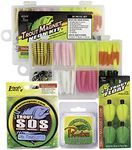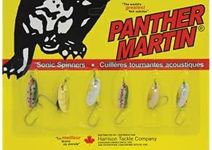Buying Guide for the Best Rainbow Trout Lures
Choosing the right rainbow trout lure can make your fishing experience much more enjoyable and successful. The best lure for you depends on where you’re fishing, the water conditions, and your own preferences. Understanding the key features of lures will help you select one that matches your fishing style and the behavior of rainbow trout in your area. By learning about the main specifications, you’ll be able to make a confident choice and increase your chances of catching more fish.Lure TypeLure type refers to the general category or style of the lure, such as spinners, spoons, soft plastics, or crankbaits. This is important because different types of lures mimic different kinds of prey and behave differently in the water. Spinners create flash and vibration, spoons wobble and reflect light, soft plastics imitate worms or insects, and crankbaits look like small fish. To choose the right type, think about the natural food sources in your fishing spot and how active the trout are. If you’re unsure, starting with a spinner or spoon is a safe bet, as these are versatile and effective in many situations.
Lure SizeLure size is usually measured in length or weight and affects how the lure moves and what size fish it attracts. Smaller lures (1-2 inches or 1/16-1/8 oz) are great for clear water and when trout are feeding on small insects or fry. Medium sizes (2-3 inches or 1/8-1/4 oz) are good all-rounders for most conditions. Larger lures (over 3 inches or 1/4 oz and up) can attract bigger trout or be used in murky water. Match the size of your lure to the size of the trout you’re targeting and the clarity of the water—smaller for clear water and finicky fish, larger for stained water or when targeting trophy trout.
ColorLure color can make a big difference in attracting trout, as it affects visibility and how natural the lure appears. Bright colors like chartreuse, orange, or pink work well in murky water or on cloudy days, while natural colors like silver, gold, brown, or green are better for clear water and sunny conditions. If you’re not sure, start with a silver or gold lure, as these often mimic the flash of small fish. Adjust the color based on water clarity, light conditions, and how aggressive the trout seem to be.
ActionAction describes how the lure moves in the water, such as wobbling, spinning, darting, or vibrating. This is important because different actions can trigger strikes from trout depending on their mood and the conditions. Fast, erratic actions can attract aggressive fish, while slow, subtle movements are better for cautious or pressured trout. When choosing, consider how active the fish are—if they’re biting aggressively, go for a lure with lots of action; if they’re shy, pick something with a more natural, gentle movement.
Hook Type and SizeThe hook type and size affect how well you can hook and land a trout. Single hooks are easier to remove and less damaging to fish, making them good for catch-and-release, while treble hooks can increase your chances of hooking a fish but may be harder to remove. Smaller hooks are better for smaller trout and when using small lures, while larger hooks are suited for bigger fish and larger lures. Match the hook size to the lure and the size of trout you expect to catch, and consider local regulations, as some areas require single, barbless hooks.


















